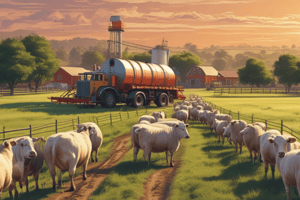Podcast
Questions and Answers
Which of the following strategies is LEAST likely to be considered a primary method in food production for crop protection?
Which of the following strategies is LEAST likely to be considered a primary method in food production for crop protection?
- Exclusive reliance on synthetic pesticides without regard for environmental impact. (correct)
- Biological control methods.
- Cultural control practices.
- Behavioral pest management.
How does Integrated Pest Management (IPM) align with Good Agricultural Practices (GAP) regarding pesticide use?
How does Integrated Pest Management (IPM) align with Good Agricultural Practices (GAP) regarding pesticide use?
- IPM advocates for the exclusive use of synthetic pesticides to protect crops from pest damage.
- IPM, as part of GAP, aims to minimize pesticide residues by following GAP guidelines, ensuring residues in crops do not exceed the Maximum Residue Limit (MRL). (correct)
- IPM operates independently of GAP, focusing solely on maximizing crop yields without considering pesticide residue levels.
- IPM encourages the use of broad-spectrum pesticides to eradicate all pests, regardless of potential harm to beneficial organisms.
A farmer exports bananas and discovers the fungicide residue level in their produce exceeds the lowest MRL set for that fungicide in similar tropical fruits. Based on Codex MRL guidelines, what is the most probable outcome?
A farmer exports bananas and discovers the fungicide residue level in their produce exceeds the lowest MRL set for that fungicide in similar tropical fruits. Based on Codex MRL guidelines, what is the most probable outcome?
- The banana exports will be accepted, as long as the residue level is below the Codex MRL standard.
- The banana exports will be rejected, as the Codex MRL standard requires adherence to the lowest MRL specified for similar agricultural products. (correct)
- The banana exports will still be accepted, as long as the fungicide is approved for use in the exporting country.
- The banana exports will be rejected only if the importing country has stricter MRL standards than Codex.
What is the primary reason for Japan and South Korea's adoption of stringent Maximum Residue Limit (MRL) standards, including a "positive" MRL list, for imported fruits?
What is the primary reason for Japan and South Korea's adoption of stringent Maximum Residue Limit (MRL) standards, including a "positive" MRL list, for imported fruits?
What's the MOST effective approach to minimize pesticide exposure while spraying crops, particularly concerning the parts of the body that are most susceptible to residue?
What's the MOST effective approach to minimize pesticide exposure while spraying crops, particularly concerning the parts of the body that are most susceptible to residue?
Which practice provides the LEAST effective reduction of pesticide residues on fruits and vegetables before consumption?
Which practice provides the LEAST effective reduction of pesticide residues on fruits and vegetables before consumption?
Why is it important to avoid recycling empty pesticide containers for storing food or feed stuff?
Why is it important to avoid recycling empty pesticide containers for storing food or feed stuff?
What is the significance of the Pre-Harvest Interval (PHI) in pesticide application, and how does it relate to Maximum Residue Limits (MRLs)?
What is the significance of the Pre-Harvest Interval (PHI) in pesticide application, and how does it relate to Maximum Residue Limits (MRLs)?
What should be considered when choosing a location for a pesticide disposal pit?
What should be considered when choosing a location for a pesticide disposal pit?
If a pesticide label recommends specific Personal Protective Equipment (PPE) for mixing and applying the product, what is the MOST critical reason for adhering to these recommendations?
If a pesticide label recommends specific Personal Protective Equipment (PPE) for mixing and applying the product, what is the MOST critical reason for adhering to these recommendations?
In what way does CODEX Alimentarius Commission impact global trade practices related to agricultural products, specifically in terms of Maximum Residue Limits (MRLs)?
In what way does CODEX Alimentarius Commission impact global trade practices related to agricultural products, specifically in terms of Maximum Residue Limits (MRLs)?
How do ash and sawdust (or coconut coir) each contribute to decontaminating a pesticide disposal pit?
How do ash and sawdust (or coconut coir) each contribute to decontaminating a pesticide disposal pit?
In the context of the Philippines submitting pesticide residue data to Japan and Korea, what was the primary purpose of providing this data to these regulatory agencies?
In the context of the Philippines submitting pesticide residue data to Japan and Korea, what was the primary purpose of providing this data to these regulatory agencies?
What is the most significant risk associated with neglecting to properly launder work clothes used during pesticide application?
What is the most significant risk associated with neglecting to properly launder work clothes used during pesticide application?
What is the significance of conducting supervised pesticide residue trials in the context of determining the Pre-Harvest Interval (PHI)?
What is the significance of conducting supervised pesticide residue trials in the context of determining the Pre-Harvest Interval (PHI)?
What is the key consideration when selecting pesticides for use in Good Agricultural Practices (GAP)?
What is the key consideration when selecting pesticides for use in Good Agricultural Practices (GAP)?
Which activity poses the greatest risk of pesticide exposure after spraying?
Which activity poses the greatest risk of pesticide exposure after spraying?
What is the primary objective of Good Agricultural Practices (GAP) related to Maximum Residue Limits (MRLs)?
What is the primary objective of Good Agricultural Practices (GAP) related to Maximum Residue Limits (MRLs)?
If grains are grouped together as a food group with a MRL of 0.01 mg/kg, and your aromatic rice has residues that may be higher than this due to pest control issues, what is the most likely outcome for export?
If grains are grouped together as a food group with a MRL of 0.01 mg/kg, and your aromatic rice has residues that may be higher than this due to pest control issues, what is the most likely outcome for export?
What is the primary harm in using non-recommended pesticides?
What is the primary harm in using non-recommended pesticides?
Flashcards
Good Agricultural Practices (GAP)
Good Agricultural Practices (GAP)
Practices aimed at ensuring safe and sustainable agricultural production, including judicious pesticide use.
Maximum Residue Limit (MRL)
Maximum Residue Limit (MRL)
The highest concentration of a pesticide residue allowed in food or feed, set to protect consumer health and facilitate trade.
Pre-Harvest Interval (PHI)
Pre-Harvest Interval (PHI)
The time between the last pesticide application and harvest, ensuring residues are within safe limits.
Integrated Pest Management (IPM)
Integrated Pest Management (IPM)
Signup and view all the flashcards
Pesticide application compliance
Pesticide application compliance
Signup and view all the flashcards
Home processing for residue reduction
Home processing for residue reduction
Signup and view all the flashcards
Personal Protective Equipment (PPE)
Personal Protective Equipment (PPE)
Signup and view all the flashcards
Safe pesticide storage
Safe pesticide storage
Signup and view all the flashcards
Proper container disposal
Proper container disposal
Signup and view all the flashcards
Compliance with GAP
Compliance with GAP
Signup and view all the flashcards
Study Notes
- Good Agricultural Practices (GAP) and Maximum Residue Limit (MRL) are important aspects of pesticide management
- The session aims to understand GAP, pesticide management, MRL, reducing pesticide residues, proper handling, storage, and disposal of pesticides
Introduction to Pesticide Management
- Food production uses strategies like biological, chemical, cultural, behavioral and ecological pest management
- Pesticide management includes manufacturing, distribution, use, and disposal
- Pesticide management is a GAP component, addressing food safety, worker safety, environmental protection, and improved fruit quality
Reducing Pesticide Residues in Food
- Strict compliance with pesticide use guidelines consistent with GAP is vital
- Use registered pesticides for specific crops
- Follow the label for dosage, timing, frequency, and pre-harvest interval (PHI)
- Practice Integrated Pest Management (IPM) so residues in the crop will not exceed the MRL
- PHI is the number of days between the last spraying and harvest
- PHI is derived from supervised residue trials, and each pesticide active ingredient has its own PHI
- Commodities should not contain residues exceeding the MRL
- Residues may be present even with GAP, but will be below the MRL and acceptable for trade
Maximum Residue Limit (MRL)
- MRL is the highest pesticide concentration allowed in a crop for trade
- Exports can be rejected if pesticide residues exceed MRL, if certain pesticides are not approved in the importing country, or if there is no Philippine MRL for that pesticide
- Japan and South Korea have stringent MRL standards, including zero residue for some imports, and use a "positive" MRL list
- The Philippines provided supervised trial data to Japan and Korea for MRL evaluation
Guidelines for Pesticide MRLs
- The Codex MRL standard should apply
- Codex is the intergovernmental body approving MRLs for specific pesticides in crops in international trade
- If there is no Codex MRL, the lowest residue limit specified for similar agricultural products applies
- The lowest MRL in the food group will apply
Reducing Pesticide Residues in Food (Home Processing)
- Washing fruits and vegetables reduces pesticide residues
- Washing under running tap alone does not reduce residues considerably
- Home processes to reduce residues: washing with mild detergent, soaking in mild vinegar solution, grilling/broiling, boiling in water
Implementing Good Agricultural Practice
- Read the pesticide label properly
- Use only recommended pesticides: Use the product only for the pests found in the label
- Non-recommended pesticides can cause residue problems, health issues, and harm beneficial organisms
Handling Pesticides Safely
- Handle pesticides properly to minimize exposure
Before Mixing
- Keep equipment in good condition, check for leaks, and clean nozzles
- Read the product label for appropriate personal protective equipment (PPE)
When Measuring/Mixing
- Use measuring spoons/cups or graduated cylinders
- Avoid spillage and hand contamination by using gloves
- Triple rinse the pesticide bottle with water.
During Spraying
- Pesticide residues are highest in the face area
- For mangoes, spray the inner canopy first
- Do not spray against the wind
- Use protective headgear and cover the nose and mouth to reduce inhalation
- Use a cap and a hand towel to cover the neck area
- Wear long-sleeved shirts and pants
- Change clothes when wet and remove gloves last
- Do not smoke or eat without washing hands
After Spraying
- Clean spray equipment with detergent and water
- Do not dispose of contaminated water into waterways
- Wash hands with soap and water
- Do not wear work clothes home
Handling Clothes Used for Spraying
- Do not reuse shirts without washing
- Launder work clothes separately, soaking them in water and detergent
- Dispose of rinse water properly
Storing Pesticide Containers
- Store pesticides in their original labeled containers
- Keep pesticides in a locked storeroom, out of reach of children
- Place partially used bottles in a thick plastic bag
Disposing of Pesticide Containers
- Do not reuse bottles for food or feed
- Do not burn pesticide containers
- Dispose of empty containers in a pesticide disposal pit away from people, animals, and water sources
- Pesticides in the pit are broken down by physical, chemical, and microbial means
- Ash or lye break down pesticides through chemical reactions
- Sawdust or coconut coir capture pesticides physically
Summary of Pesticide and Residue Management
- There are ways to manage and reduce risks while spraying pesticides on crops and from pesticide residues in food
- GAP compliance leads to MRL compliance, protecting consumers and ensuring export acceptance
- Applicator exposure is managed by proper pesticide use
- Residue exposure is reduced by home processing methods
- Proper container disposal protects the environment
Studying That Suits You
Use AI to generate personalized quizzes and flashcards to suit your learning preferences.




